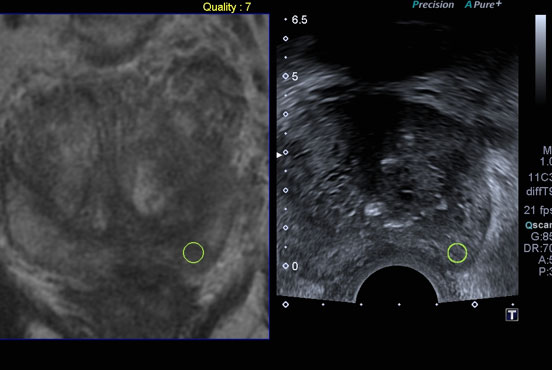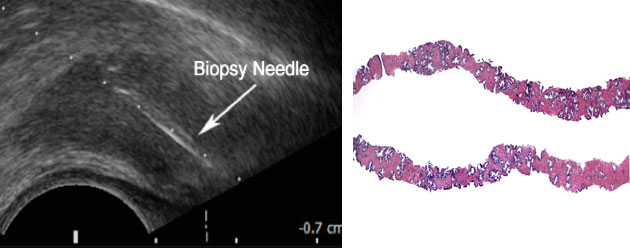Prostate Biopsy
Why have a Prostate biopsy?
A prostate biopsy will have been recommended if your;
- PSA was elevated
- The rectal examination was abnormal or wrong
- The PSA is too high for the volume of the prostate gland.
- Or for follow-up of patients on active surveillance for low volume low-grade prostate cancer.
The decision to have a biopsy may have been influenced by a strong family history of prostate cancer. It is common in my practice to have had an MRI of the prostate before the biopsy.
How is a prostate biopsy performed?
Prostate biopsies can be performed either through the rectum or through the skin under the scrotum. If carried out through the rectum, this is called a transrectal biopsy. If through the skin, a transperineal biopsy. This brochure describes the common transrectal biopsy (TRUS).
What is a trans-rectal prostate biopsy?
A transrectal (TRUS) prostate biopsy is done with the patient awake lying on their side. Local anaesthetic is put around the prostate before the biopsy. This is left for 5 minutes before the biopsies are taken. An ultrasound probe looks at the prostate and a series of biopsies with an automated biopsy gun are then taken. The MRI pictures will be used to guide the sites biopsied.
The biopsy gun fires a thin needle into the prostate and the needle takes a tiny sliver of tissue from the prostate, each time. The procedure is usually more uncomfortable than painful. The tissue specimen is then sent away to a pathologist to examine.
What we see on the ultrasound prostate cores as sent off to pathologist
A transrectal (TRUS) biopsy
What we see on the ultrasound and prostate cores as sent off to pathologist
Will it hurt?
If the local anaesthetic is left long enough most people feel an uncomfortable sensation more like a kick in the backside than true pain. I always leave the local to work for 5 minutes before the biopsy. Sometimes the local itself is more painful than the procedure. If you have anal stenosis (a very tight bottom) and cannot tolerate a rectal examination, then a TRUS biopsy will require sedation or a general anaesthetic.
Can I drive after?
Yes, after a TRUS-guided biopsy most people can drive. I always think it is a good idea to take the day off work and rest afterwards. If I have indicated before the biopsy that you will need sedation then you will need a driver. Sedation is more common if you are having an MRI/US fused biopsy.
Why did I have an MRI before my biopsy?
Grey scale ultrasound does not see prostate cancers well most of the time. MRI is the best way of looking for prostate cancer and can then direct the biopsy to the correct area. Also if the MRI is normal and the biopsy normal then we can be very sure that we have not missed any cancers.
What is MRI/US fused biopsy?
Once we have an MRI picture of the prostate then we need to aim the biopsy needle at any abnormal areas identified. This can be done by looking at the MRI pictures while taking the biopsy and trying to estimate where the same area is on the ultrasound. This is called “cognitive” fusion, and can be very effective if you are experienced at it.
A more elegant approach is to get the computer in the ultrasound machine to match the MRI pictures to the ultrasound picture. Once this has been done the US and MRI pictures move together in real time, side by side. The abnormal area on the MRI is marked and the corresponding area on the ultrasound displayed. To do this the machine records the movement of the ultrasound using a micro GPS tracking system. For this to work you cannot move once the initial fusion has been set up. To make this easier a little bit of sedation may be used.

An MRI picture is on the left, the ultrasound picture on the right. The yellow circle shows the target area.
What can go wrong with my biopsy?
With all biopsies, there is a risk of bleeding and infection. Before your biopsy you should have had a rectal swab taken to look for resistant bacteria. If these are present, then the antibiotic you take will be changed to cover for the bacteria detected. With this new approach the risk of infection is very very low. This new approach and its impact on reducing infection rates, although not pioneered by Waikato Hospital, was introduced here very early on.
If you develop feelings of
- Shivering,
- Shaking or
- Fevers
Then you should contact your doctor, Michael Holmes or the hospital emergency department immediately.
What do I need to do before my biopsy?
Usually 2 hours before your biopsy you should take
- 2 antibiotic tablets and
- 2-3 paracetamol tablets.
- And have had a small enema.
The enema is to clear out the rectum to ensure the pictures taken during the ultrasound are as clear as possible.
If you are travelling some distance to your biopsy then please ignore the 2 hours before biopsy instruction and take the enema at least half an hour to forty-five minutes before travelling so that the effects can be over before you start driving.
Further information can be found at the following websites
http://www.hopkinsmedicine.org/healthlibrary/test_procedures/urology/prostate_biopsy_92,P07710/

